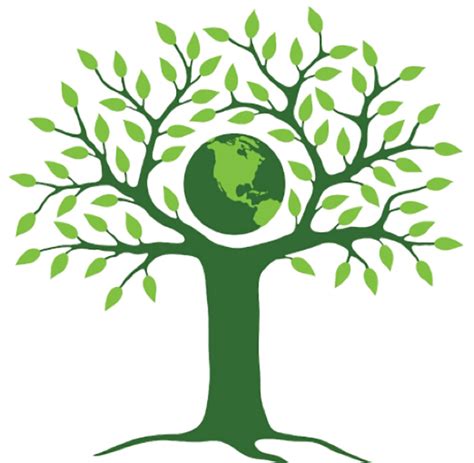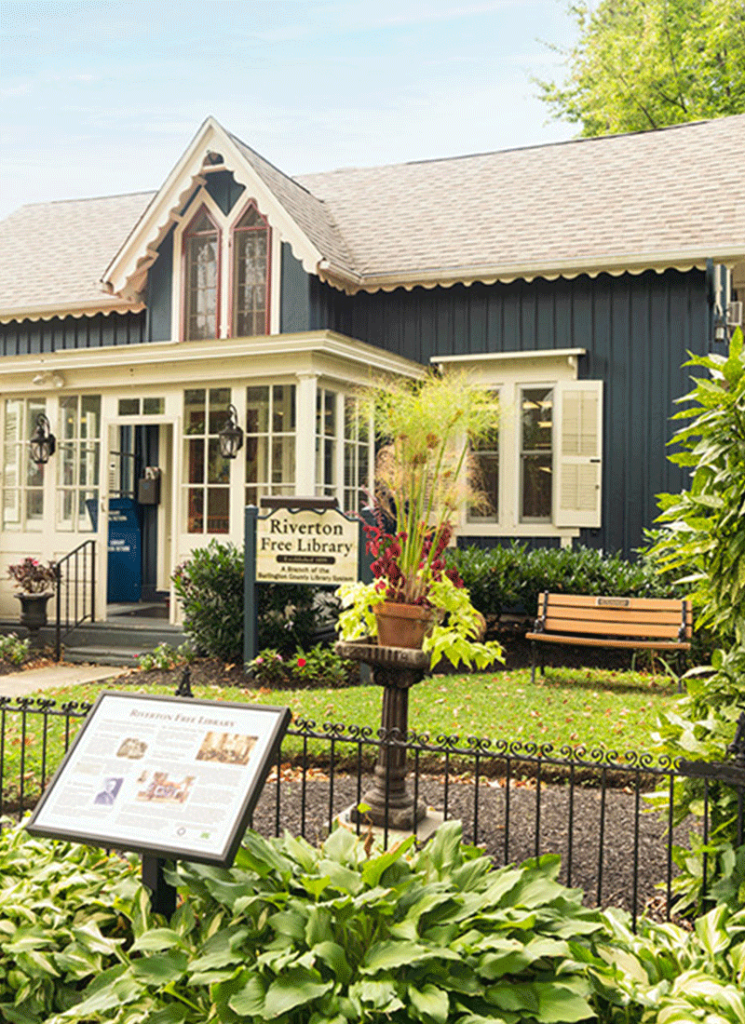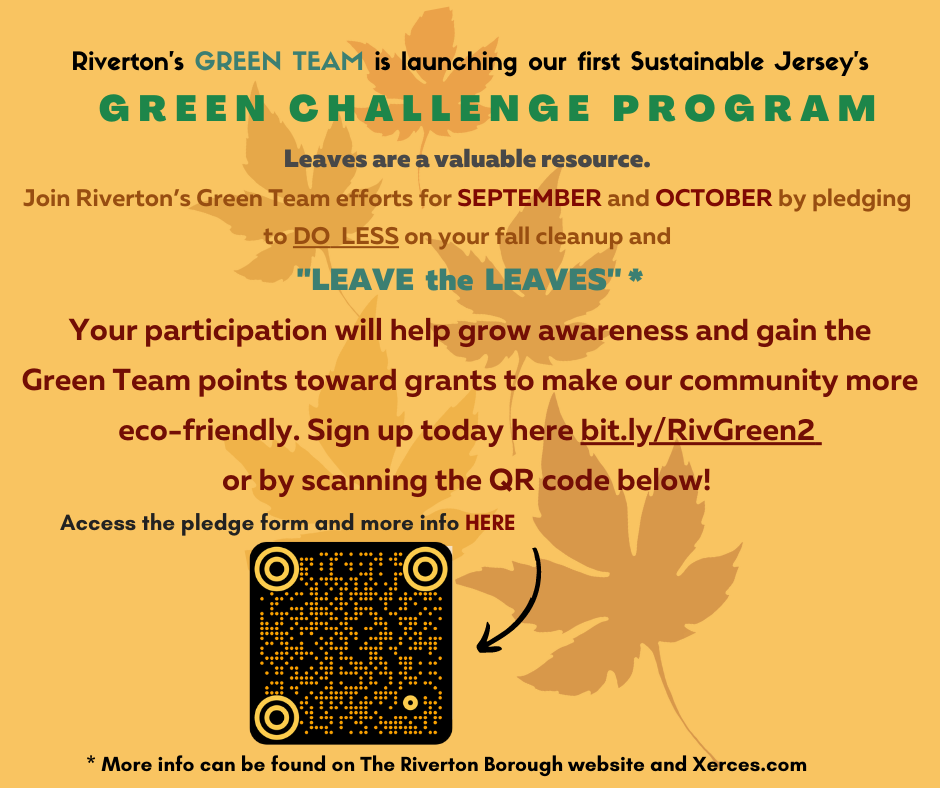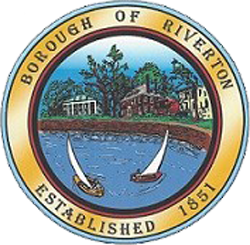Environmental Commission
& Green Team
Environmental Commission
Environmental resource inventory 2008
Meetings are held on the third Thursday every month jointly with the Green Team, 7:30 pm
at Brewery 33, 601 Lippincott Ave, Riverton, NJ
Why Plant Natives?
The Importance of Native Plant Species in Our Landscapes
When non-native or exotic invasive plants are introduced to an area and have no natural predators, they can displace native species. Many of these were intentionally brought to North America as ornamentals from other continents. They often have attractive flowers, foliage, or fruit, but “invasives” disrupt natural ecosystems, wildlife food sources and habitats, water flow, and soil health. Invasive exotic plants may also produce lots of seeds that can spread into woodlands. Some examples are Callery/Bradford pear, Chinese privet, Chinese and Japanese wisteria, and Chinese elm. Others produce a thick canopy and shade out native species or substances that prevent seed germination, like Asian Honeysuckles and Oriental Bittersweet.
In the past we gardened for food consumption, then aesthetics. Now, with changing climate and loss of habitat beauty alone should not be the only justification for selecting a plant for the landscape. Native shrubs, vines, and trees support insects, such as adults and larvae of beetles, butterflies, moths, ants, and flies. Certain insects depend on native flora as hosts for the larval stage and the berries and seeds for adults. Studies have shown that birds need a lot of insects to feed and fledge their chicks, with at least 70% native vegetation. Food webs depend on plants for energy, oxygen, and carbohydrates. Decomposing leaves build soil; the leaf litter and humus are essential to the microbes that recycle those nutrients.
Right Plant Right Place
When selecting plants for our landscapes, we consider form, mature height and width, and site conditions like light, moisture, and hardiness. Just as important are the ecological services that a species offers. Our native grasses, perennials, trees, shrubs, vines, and groundcovers are often the best choices for preserving ecosystems, using fewer pesticides and irrigation because they are adapted to the climate, heat, and humidity of our region. Please do a little googling or check your local extension service to understand the needs of a specific plant.
Knowing what to ask for when shopping at a garden center is key. Common names can vary regionally, so knowing the scientific name (genus and species) will avoid any confusion. There are many species of oaks, hollies, and laurels, and sometimes the common name or scientific name may indicate the origin of the plant, for example, Chinese silvergrass (Miscanthus sinensis), Japanese wisteria (Wisteria japonica) or American elm (Ulmus americana).
Click Below for Some Great Resources:
Monthly Newsletters
Buying Native Plants: Always ask your local nursery if they stock native NJ plants. Even if they don’t they will know their customers are interested and it may help them to start.
On-line Resources
- BONAP’s North American Plant Atlas (gives you a color coded guide by state or county to native and non native species.
Jersey Friendly Yards Interactive Design Tool - Jersey Friendly Yards Plant List
- Jersey Friendly Yards – Where to Buy Natives
- NJ Native Plant Society
- NJ Native Plant Society Plant List
- Bowman’s Hill Wild Flower Preserve
- Transitioning your Garden
- Invasive Plants
Learn more about pollinators with The Xerces Society
Reading List
- Noah’s Garden, Sara Stein
- Bringing Nature Home: How Native Plants Sustain Wildlife in Our Gardens, Douglas W. Tallamy
- A New Garden Ethic, Benjamin Vogt
- Planting in a Post Wild World, Thomas Ranier and Claudia West
- Nature’s Best Hope, Douglas W. Tallamy
- Planting: A New Perspective, Piet Oudolf
| Environmental Commission (Term 3 Years) | ||||
|---|---|---|---|---|
| Jim Quinn, Council Liaison | 629 Elm Terrace | (856) 829-0120 | [email protected] | 12-31-2026 |
| Edgar Wilburn, Councilman | - | - | [email protected] | 12-31-2026 |
| Nicole Rafter, Councilwoman | - | - | [email protected] | 12-31-2026 |
| Kathryn Simon, Chair | 304 Penn St | (215) 837-8329 | - | 12-31-2026 |
| Michael Robinson, Secretary | 6 Second St | (215) 829-8329 | - | 12-31-2025 |
| Joseph Threston | 307 Seventh St | (856) 303-1310 | 12-31-2025 | (Planning Board Representative) |
| Katie Lucas | 631 Lippincott Ave | - | - | 12-31-2025 |
| Stephanie Brown | 628 Linden Avenue | - | - | 12-31-2025 |
| Alternate Environmental Commission (Term 2 Years) | |||
|---|---|---|---|
| Kim Piotrowski | - | - | 12-31-2024 |
| Nicole Belolan | 605 Thomas Avenue | - | 12-31-2024 |

Riverton Green Team (Term 1 Year)
Katie Lucas, Chair
631 Lippincott Ave.
12-31-2022
Kate Johnson
431 Thomas Avenue
12-31-2022
Christian Hochenberger
431 Thomas Avenue
12-31-2022
Lynn Johnson
303 Midway
12-31-2022
Stephanie Brown
628 Linden Ave.
12-31-2022
Erin Matzelle
710 Thomas Avenue
12-31-2022
Pat Brunker
12-31-2022
Nedra Cawley
12-31-2022

Riverton Green Team (Term 1 Year)
Meetings are held on the third Thursday every month jointly with the Environmental Commission, 7:30 pm at Brewery 33, 601 Lippincott Ave, Riverton, NJ
-
Jim Quinn, Council Liaison
[email protected]
12-31-2023 -
Katie Lucas, Chair
631 Lippincott Ave.
12-31-2023 -
Nicole Belolan
605 Thomas Avenue
12-31-2023 -
Stephanie Brown
628 Linden Ave.
12-31-2023 -
Pat Brunker
200 Second St.
12-31-2023 -
Erin Matzelle
710 Thomas Ave.
12-31-2023
-
Edgar Wilburn
Councilman
12-31-2024 -
Scott Reed
Councilman
12-31-2024 -
Kim Piotrowski
12-31-2023 -
Kathryn Simon
304 Penn St
(215) 837-8329
12-31-2023 -
Sharon Stokes
12-31-2023 -
Hal Feinstein
211 Linden Ave.
12-31-2023
We Are Making a Difference:

Environmental Commission (Term 3 Years)
Stephanie Brown
628 Linden Avenue
12-31-2022
Environmental Commission (Term 3 Years)
Katie Lucas
631 Lippincott Avenue
12-31-2022
Riverton Green Team (Term 1 Year)
Stephanie Brown
628 Linden Avenue
12-31-2021
Kate Johnson
431 Thomas Avenue
12-31-2021
Christian Hochenberger
431 Thomas Avenue
12-31-2021
Lynn Johnson
303 Midway
12-31-2021
Katie Lucas
631 Lippincott Avenue
12-31-2021
Erin Matzelle
710 Thomas Avenue
12-31-2021
Vacant
12-31-2021
Green Challenge Program
Riverton’s Green Team is organizing a challenge toward Sustainable Jersey points this fall. We are asking residents to pledge to do less on your fall clean-up and “Leave the Leaves” this September and October. This will help us in our efforts to become eligible for grant money to further use within the Borough and our efforts. Please sign the pledge here. Our goal is to get 2.5% of Riverton households to participate!

